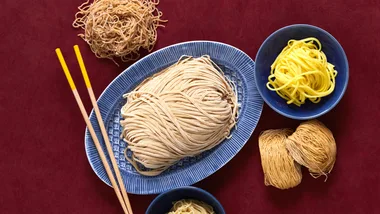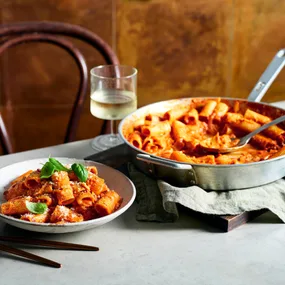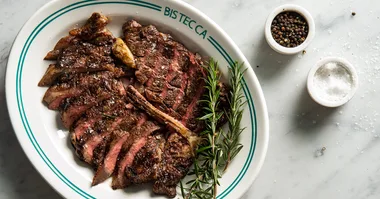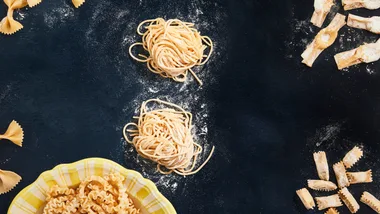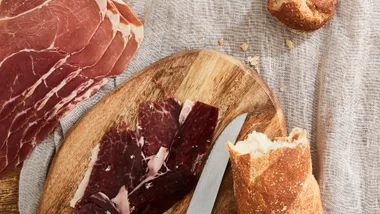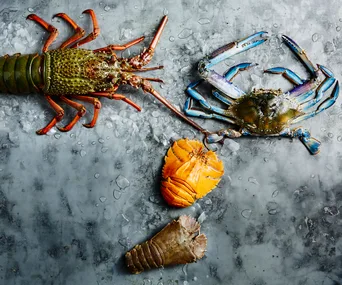I’ve made the decision to buyonly free-range, preferably rare-breed pork from now on. The flavour of a rare breed such as Large Black, Tamworth or Wessex Saddleback is just so much better; it’s richer and more complex. Commercial pork can be lean and dry but the meat on these rare breeds is succulent because there’s more marbling. Even the colour is different: it’s dark and rosy, almost like a completely different meat.
The first rare-breed pork I cooked was a leg of Large Black pig from farmer Christine Ross in Victoria’s Yarra Valley. It cooked up magnificently. I rubbed the flesh with olive oil, chopped rosemary and pepper, then scored the skin and seasoned it heavily with salt, and roasted it on a bed of chopped onion, carrot and celery. As it roasted, the juices combined with the herbs and vegetables and made a delicious sauce. This pork was sweet, aromatic and rich, and it had the most gloriously crunchy crackling. I remember looking at the amount of fat pushing up underneath the crackling and thinking, “Wow, that’s a lot of fat”. But it wasn’t just any fat. When I put it in my mouth, it burst into a melting sweetness.
Why is this pork so special? Rare-breed pigs are old breeds that were bred for flavour – they are usually much slower-growing than your conventional white pig, which is bred for intensive farming. They are better suited to free-ranging because they are quite hardy and have coloured skin to protect them from sun. These pigs are free to roam on pastures, graze grass, wallow in mud and use their muscles to move around – in short, to act like natural pigs.
They do not have their teeth clipped or tails docked so they are, importantly, stress-free, and therefore make for better eating. The result is that the meat is juicy and tender thanks to the higher fat content. I would normally trim all the fat before I eat pork, but with these pigs the quality of the fat is sublime.
The excellent news is that there is a growing number of farmers in Australia breeding free-range, rare-breed pigs and you can buy them at farmers’ markets. Rare-breed pork can cost as much as $25 a kilo but it is worth every cent.
A pig is incredibly versatile – you can eat almost every part of the animal except the oink. Some of my favourite ways to enjoy pork are as schnitzels covered in fresh breadcrumbs with grated parmesan and chopped sage, and barbecued chops marinated in olive oil, smoked paprika, crushed garlic and oregano leaves and finished with a squeeze of lemon. My Italian butcher cures his own pork cheeks, or guanciale, which I fry and serve with scrambled eggs for breakfast. And you can’t beat pickled pork belly – poached soft and then roasted until it’s brown and crisp.
Rillettes is something I am particularly fond of in winter. Making rillettes on a cold day imparts a lovely comforting fragrance into the house. I place large pieces of pork belly in a casserole with bay leaves, allspice, cinnamon and peppercorns, cover it with melted pig or duck fat and simmer it for a few hours until meltingly tender. I shred the meat with a fork, season, and pack it into ceramic dishes, then strain over enough fat from the pan to cover by 1cm. It will keep refrigerated for a couple of months. The best rillettes I have ever made was from the pork belly of a Fernleigh Farms Wessex Saddleback – light, creamy and complex in flavour. I love it spread on toast and eaten with cornichons or pickled morello cherries.
But my all-time favourite is roast leg or shoulder of pork with crackling and apple sauce. I flavour the meat with chopped rosemary, lemon zest, garlic, crushed fennel seeds, ground pepper and extra-virgin olive oil. I score the skin and salt it heavily (brushing off the salt afterwards) and roast it in a very hot oven, about 220C, for 20 minutes or until the crackling has well and truly started to bubble, and then I reduce it to 170C and cook it until well done. Of course, I make sure to rest it for 15 minutes before carving.
 Antonia Pesenti
Antonia Pesenti

